
HOW TO PAINT EXTERIOR WALL*
Painting the exterior wall of a house may seem quite simple, but it is not always the case. If you are not familiar with all the intricacies involved, it can not only cost you extra money but also require repainting in a short period of time. That's why we want to show you in this article how to properly paint the walls of your house like a true painter.
 Table of contents
Table of contents
- HOW TO PAINT EXTERIOR WALL
- CAN I PAINT MY HOUSE EXTERIOR IN THE UK? UNDERSTANDING COUNCIL IMPOSED COLOUR RESTRICTIONS
- 4 REASONS WHY YOU SHOULD PAINT YOUR EXTERIOR WALL
- 5 SIGNS INDICATING THAT YOU SHOULD NOT PAINT THE EXTERIOR WALL
- WHAT COLOUR SHOULD I CHOOSE?
- 4 POPULAR EXTERIOR WALL COLOURS IN UK
- WHAT PAINT TO USE ON EXTERIOR WALLS?
- BEST PAINT FOR OUTSIDE WALLS
- TYPES OF MASONRY PAINT
- HOW MUCH PAINT WILL I NEED?
- MASONRY PAINT SIZES | MANUFACTURERS
- WHAT IS THE COST OF PAINTING A HOUSE?
- DO I REALLY NEED TO WASH EXTERIOR WALLS BEFORE PAINTING?
- DO YOU NEED TO PRIME EXTERIOR WALLS BEFORE PAINTING?
- HOW DO YOU PREPARE AN EXTERIOR WALL FOR PAINTING?
- EQUIPMENT
- PREPARE THE SURFACE/HOW TO CLEAN EXTERIOR WALLS BEFORE PAINTING
- REPAIRING CRACKS
- STAINS
- PAINT THE WALL WITH RIGHT TOOLS
- BE CLEVER
- CUT WISELY
- BE FAST
- BE CLEAN
- HOW TO PAINT OUTSIDE OF THE HOUSE WITHOUT SCAFFOLDING?
- BIBLIOGRAPHY
CAN I PAINT MY HOUSE EXTERIOR IN THE UK? UNDERSTANDING COUNCIL IMPOSED COLOUR RESTRICTIONS
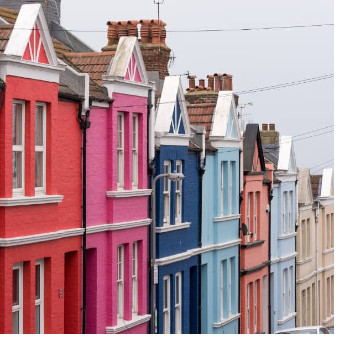 When it comes to painting the exterior of your house in the UK, it is important to first check with your local Council to see if there are any restrictions on the colours you can use. Some Councils have regulations in place that dictate the specific colours that can be used on homes in certain areas, in order to maintain a certain aesthetic or heritage character.
When it comes to painting the exterior of your house in the UK, it is important to first check with your local Council to see if there are any restrictions on the colours you can use. Some Councils have regulations in place that dictate the specific colours that can be used on homes in certain areas, in order to maintain a certain aesthetic or heritage character.
For instance, some conservation areas may have strict guidelines for what colours are allowed to preserve the historic character of the area.
Additionally, some newer housing developments may have covenants that limit the range of colours that can be used in order to maintain a consistent look and feel.
It is important to note that if you fail to comply with these regulations, you may face fines or be required to repaint your home in a different colour.
However, if your Council does not have any restrictions in place, then you are free to choose from a wide range of colours and finishes for your home's exterior. When selecting a colour, consider factors such as the style of your home, the surrounding landscape, and any other architectural features that you want to highlight.
Overall, it is important to do your research and understand any council-imposed restrictions before embarking on an exterior painting project in the UK. By doing so, you can ensure that your home looks great while avoiding any potential legal issues.
4✔ REASONS WHY YOU SHOULD PAINT YOUR EXTERIOR WALL
Painting your exterior walls can be a great investment for your property. Here are 4 reasons why you should consider painting your exterior walls:
1. DIRTY WALL
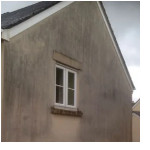 Over time, external walls can become dirty and stained due to weather conditions.
Over time, external walls can become dirty and stained due to weather conditions.
Painting your exterior walls can help to restore the original appearance of your building, making it look fresh and clean. This can also help your building to stand out from others in the area.
2. SELLING PROPERTY
 When you are selling your property, first impressions count. Potential buyers are likely to be put off by a building that looks old, tired, or in need of repair.
When you are selling your property, first impressions count. Potential buyers are likely to be put off by a building that looks old, tired, or in need of repair.
Painting your exterior walls can help to create a positive first impression, making your property more attractive to potential buyers.
3. PAINT IS PEELING OFF
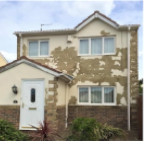 If the paint on your external walls is peeling off, it can make your building look neglected and uncared for.
If the paint on your external walls is peeling off, it can make your building look neglected and uncared for.
Painting your exterior walls can help to prevent further damage and help to improve the overall appearance of your property, making it look more attractive and well-maintained.
4. UPDATE
 Sometimes, you may simply feel like painting your exterior walls. Maybe you want to update the look of your building, or maybe you just want to try out a new colour.
Sometimes, you may simply feel like painting your exterior walls. Maybe you want to update the look of your building, or maybe you just want to try out a new colour.
Painting your exterior walls can be a fun and creative project, allowing you to express your personal style and add value to your property.
5✔ SIGNS INDICATING THAT YOU SHOULD NOT PAINT THE EXTERIOR WALL
Painting the exterior walls of a building is a great way to give it a fresh look and protect it from the elements. However, there are certain circumstances in which you should not paint the exterior walls. Here are a few instances when you should avoid painting the exterior walls:
1. WEATHER
 It is best to avoid painting the exterior walls when the weather is too hot or too cold. Extreme temperatures can affect the quality of the paint and cause it to peel or crack.
It is best to avoid painting the exterior walls when the weather is too hot or too cold. Extreme temperatures can affect the quality of the paint and cause it to peel or crack.
Ideally, you should paint the exterior walls when the temperature is between 18 and 25 degrees Celsius.
2. DAMP SURFACE
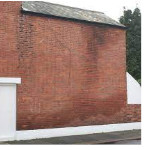 Painting a wet or damp surface can lead to adhesion problems and cause the paint to peel or bubble. Make sure the surface is completely dry before you start painting.
Painting a wet or damp surface can lead to adhesion problems and cause the paint to peel or bubble. Make sure the surface is completely dry before you start painting.
3. GREASY SURFACE
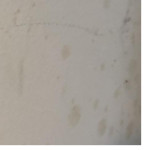 A dirty or greasy surface can prevent the paint from adhering properly. Make sure to clean the surface thoroughly before you start painting.
A dirty or greasy surface can prevent the paint from adhering properly. Make sure to clean the surface thoroughly before you start painting.
You can use a pressure washer or a scrub brush to remove dirt, grime, and grease.
4. MOULD ON SURFACE
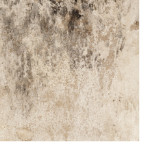 Painting over mould or mildew can cause it to spread and make the problem worse. Make sure to remove any mould or mildew before you start painting.
Painting over mould or mildew can cause it to spread and make the problem worse. Make sure to remove any mould or mildew before you start painting.
You can use a bleach solution or a commercial mould remover to get rid of the mould.
5. CRACKING SURFACE
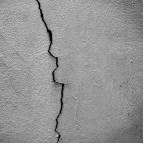 Painting over a surface that is already peeling or cracking will not fix the problem. You need to scrape off the old paint and repair any damage before you start painting.
Painting over a surface that is already peeling or cracking will not fix the problem. You need to scrape off the old paint and repair any damage before you start painting.
WHAT COLOUR SHOULD I CHOOSE?
When it comes to choosing a colour for the exterior walls of a house, there are many factors to consider. Here the list:
- STYLE
The style of your home can influence the colour you choose. Some styles lend themselves well to certain colours. For instance Victorian-style houses might be more suited to bold, bright colours.
- LANDSCAPE & SURROUNDINGS
The landscape and surroundings of your home can also be a factor in choosing a colour. If you live in a heavily wooded area, you might want to consider a colour that blends in with the natural surroundings. For instance, white colour always matches oak. If your home is in a more urban area, you might want to choose a colour that stands out and makes a statement.
- YOUR OWN COLOURS
Ultimately, the colour you choose should reflect your personal style and taste. Consider what colours you are drawn to and what will make you happy every time you come home.
4✔ POPULAR EXTERIOR WALL COLOURS IN UK
Here are 5 popular colours chosen in the UK for exterior jobs, along with feelings they can evoke:
1. MAGNOLIA
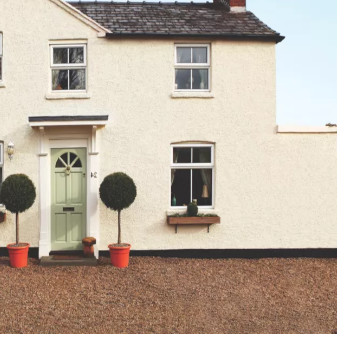 Magnolia is a warm and creamy off-white colour that is often used in home decor. It can evoke feelings of comfort, relaxation, and cosiness.
Magnolia is a warm and creamy off-white colour that is often used in home decor. It can evoke feelings of comfort, relaxation, and cosiness.
Advantages: cheap to buy, available in stores: B&Q, Wickes, Travis Perkins, Jewsons, Selco, Dulux, Layland, warm and inviting colour, it can help to conceal minor imperfections on the surface of the building, such as cracks or blemishes.
Disadvantages: outdated, attention-grabbing.
2. WHITE
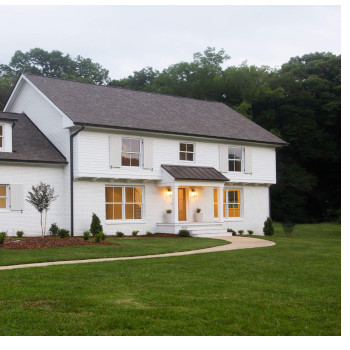 White is a timeless colour that is often associated with purity, simplicity, and cleanliness. It is a popular choice for minimalist designs and can help create a sense of spaciousness and calm.
White is a timeless colour that is often associated with purity, simplicity, and cleanliness. It is a popular choice for minimalist designs and can help create a sense of spaciousness and calm.
Advantages: bright, clean, reflects sunlight, classic and timeless, can be paired.
Disadvantages: stains more easily, difficult to keep clean, show signs of weathering, boring.
3. LIGHT GREY
 Light grey is a versatile and sophisticated colour that can be used as a neutral backdrop or as an accent colour. It can convey feelings of elegance, sophistication, and modernity.
Light grey is a versatile and sophisticated colour that can be used as a neutral backdrop or as an accent colour. It can convey feelings of elegance, sophistication, and modernity.
Advantages: modern, sophisticated, versatile.
Disadvantages: expensive to buy, need 2-3 coats, dull or uninspired colour.
4. BEIGE
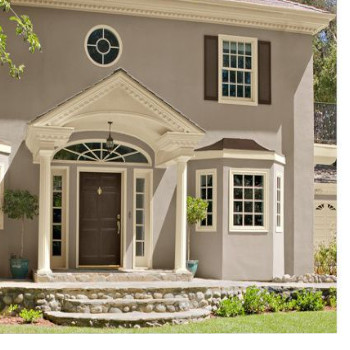 Beige is a warm and natural colour that is often used in interior design.
Beige is a warm and natural colour that is often used in interior design.
It can evoke feelings of comfort, calmness, and relaxation.
Advantages: warm, inviting.
Disadvantages: expensive,common, uninspiring.
WHAT PAINT TO USE ON EXTERIOR WALLS?
Choosing the right paint can make a significant difference in appearance and overall success of the project.
One of the most important considerations is the type of paint. For exterior walls, it is recommended to use a paint that is specifically designed for exterior use, as it will provide better protection against weather conditions, such as rain, snow, and UV rays.
Exterior paints come in various types, including oil-based, water-based, and latex-based paints. Water-based paints are among the most commonly used paints for exterior applications. They are popular because they are easy to use, do not require thinning, and have a low odour. Additionally, water-based paints are breathable, meaning they allow moisture to escape from the surface, preventing the growth of mould. They also dry faster than oil-based paints, which reduces the amount of time required for the project. Due to their versatility and user-friendliness, water-based paints have become the preferred choice for many DIY enthusiasts and professional painters alike.
UK TRUSTED PAINTS
In the UK, some of the most commonly used and trusted brands for exterior paints include EWI, Dulux, Leyland, and Farrow & Ball. These brands are well-known for their quality, durability, and wide range of colours and finishes. Dulux & EWI offers a variety of exterior paints designed for different surfaces and weather conditions, while Leyland is known for its affordability and reliability. Farrow & Ball, on the other hand, offers a premium range of exterior paints that are highly pigmented and long-lasting.
BEST PAINT FOR OUTSIDE WALLS
Choosing the best paint for outside walls is crucial for ensuring a long-lasting and durable finish. Among the top brands for exterior paints, Leyland, EWI and Dulux are highly recommended due to their quality and durability. Those brands offer exterior paints that are designed to withstand harsh weather conditions such as UV rays.
When selecting the best paint for outside walls, it is important to choose a paint that is ‘thick’. Thick paint requires only a minimal number of coats, typically one or two coats. A thick paint will provide better coverage, reducing the need for frequent repainting.
It is also important to consider the finish of the paint when choosing the best paint for outside walls.
TYPES OF MASONRY PAINT
There are a number of considerations to make when deciding on what is the best masonry paint for the job. There are also many different finishes of masonry paint that are designed, again, to be more specific to the project needs. There is coarse finish, textured, smooth gloss, matt, satin and heavily textured. Smooth masonry paint will come in different finishes depending on the manufacturer and product, such as matt, satin and gloss. Smooth masonry paint is easier to distribute across large areas and leaves a nice smooth finish – as you’d expect. You’ll find it feels similar to interior walls that you have painted. It is also excellent for covering more problematic surfaces such as pebbledash, roughcast and building blocks. If you’re painting a large surface area, then a ‘Smooth’ version is likely to be your best option as it tends to be more economical for larger areas as good quality textured masonry paints tend to be slightly more expensive per litre. Textured masonry paint offers more protection. If you live in a harsher climate such as a seaside resort or a city with a high level of pollution, texture will serve a better purpose. Its formulation is also ideal for covering fine cracks in existing surfaces so if the surface is slightly "rough", it's probably a better option to go for this type.
There are 3 main types of finish suitable for masonry surfaces:
ACRYLIC PAINT
Acrylic based masonry paints are perhaps the most common type of masonry paint on the market. It’s ideal if you have a previously painted property that simply needs ‘refreshing’ with a new coat of paint in the short term. These are plastic based paints that contain an acrylic binder. Acrylic masonry paint is cheap, quick to apply and can go over any previously painted surface. However, these ‘modern’ masonry paints have a low level of breathability meaning water vapour can’t easily pass through the painted surface. Invariably over time, water will find its way through hairline cracks in the surface where it can become trapped in the walls, eventually causing the paint to flake and bubble. Acrylic paint can be used for protecting facades, concrete constructions and interiors. It offers great value for money.
SILICATE PAINT
Those mineral based silicate paints form a physical bond with the masonry substrate. A chemical reaction allows the silicate paint to ‘knit’ into the masonry surface, becoming part of the substrate itself. It is highly breathable, durable and weather resistant.
SILICONE PAINT
Silicate paint is naturally alkaline so resists algae growth and is non-yellowing. It has a breathability level similar to that of limewash, making it ideal for older properties, conservation projects and lime render. It is regularly used on listed buildings and heritage properties. A chemical reaction with the mineral substrate means that when used together, the paint and primer form part of the surface, so it is highly durable and weather resistant. It won’t flake off and unlike limewash doesn’t need reapplying every few years.
HOW MUCH PAINT WILL I NEED?
The amount of paint needed depends on:
- THE ABSORBENCY OF THE SURFACE
For instance, a brick wall will absorb more paint than a previously painted wall.
- PAINTER SKILLS
An inexperienced painter may waste paint by splattering it around or not spreading it evenly with a roller, resulting in a greater amount of paint used.
TIP
It is estimated that 1 litre of paint will cover 8 square metres of surface area.
1m2 = 8 litres
COST
As a rough estimate, a 3 bedroom semi-detached house in the UK would require approximately 15 litres of paint for a single coat on both the front and back exterior walls. This is assuming that the surface is in good condition and has been properly prepared for painting.
MASONRY PAINT SIZES | MANUFACTURERS
Several brands can offer matt, smooth or textured exterior paint. A good quality paint should cover 7-8m2 with just 1 litre. Best selling tin sizes are:
- 0.15 ltr offering coverage 0.5m2
- 1 ltr offering coverage 8m2
- 2.5 ltr offering coverage 20m2
- 5 ltr offering coverage 40m2
- 10 ltr offering coverage 78m2
- 12 ltr offering coverage 94m2
A number of masonry paints can be matched to a specific colour, including designer shades or shades of other paint manufacturers. While the colour will not be an exact match, all paint mixing can vary, even with standard colour paints. This is why paint manufacturers always state to get all of the paint you are using mixed at the same time as colours can always vary.
Most popular masonry paint manufacturers in the UK are:
- EWI
- LEYLAND
- DULUX
- CERESIT
- K-REND
- SIKA
- B&Q
- FARROW & BALL
- SANDTEX ULTRA SMOOTH
- WICKES MASONRY SMOOTH
- ZINSSER ALL WEATHER EXTERIOR MASONRY PAINT
- RUSTIN
- JOHNSTONE
Those are the most popular smooth and textured masonry paints. They are available in 4,000+ and 1,200+ masonry paint colours – as well as black, grey, anthracite grey, and white masonry paint – with RAL, NCS, British Standard, and own-brand colours and shades.
WHAT IS THE COST OF PAINTING A HOUSE?
The cost of painting a house depend on factors such as:
- the size of the house,
- the condition of the surface,
- quality of the paint,
- the cost of labour in your area
Taking into consideration that you need 15 litres of paint for a single coat on both the front and back exterior walls of a 3 bedroom semi-detached house in the UK, the total amount of paint needed for two coats would be 30-40 litres.
A high-quality exterior paint such as EWI or DULUX can cost around £30-£50 per 5-litre can. Generally speaking you should expect to pay around £180-£400.
Please note, this is just an estimated cost and does not include the cost of:
- labour,
- filler,
- roller,
- paint brush,
- sandpaper,
- dust sheet
- extension pole,
- paint tray.
DO I REALLY NEED TO WASH EXTERIOR WALLS BEFORE PAINTING?
It is always recommended to wash the exterior wall, but it's not always necessary. If the wall is relatively clean and there's no visible dirt or grime buildup, you can skip the washing step. However, if the wall has heavy dirt, grime, or mould, it may be worth washing exterior walls to ensure the paint adheres properly. Also, if you're painting a small area, such as a patch or touch-up, washing the wall isn't always necessary.
DO YOU NEED TO PRIME EXTERIOR WALLS BEFORE PAINTING?
It is best to use a primer if the wall that you want to paint is heavily dirty and dusty, especially in areas like busy roads. Priming increases the paint's adhesion to the surface and creates a barrier that prevents the wall from absorbing too much paint, resulting in paint savings. However, if you're refreshing a wall that was previously painted 2-3 years ago, it's not as necessary to prime it again.
HOW DO YOU PREPARE AN EXTERIOR WALL FOR PAINTING?
Preparing an exterior wall for painting can be messy and there are some hazards, so wear gloves, eye protection and a breathing mask throughout the job.
Proper preparation ensures that the paint adheres well to the surface and lasts longer. Here are the steps to prepare an exterior wall for painting:
EQUIPMENT
- safety goggles,
- protective clothing,
- protective gloves,
- knee pads,
- dust mask,
- hand brush,
- flat scraper,
- filler knife,
- step ladder
- paint tray,
- extension pole,
- dust sheet.
PREPARE THE SURFACE/HOW TO CLEAN EXTERIOR WALLS BEFORE PAINTING
Use a medium to stiff bristle hand brush to give the wall a through brush to remove any surface dirt and loose paint. Then use a scraper to remove any flaking paint or loose masonry. Then brush down again if necessary.

If the wall is really dirty, you may need to scrub it with diluted household detergent and rinse it off with clean water.
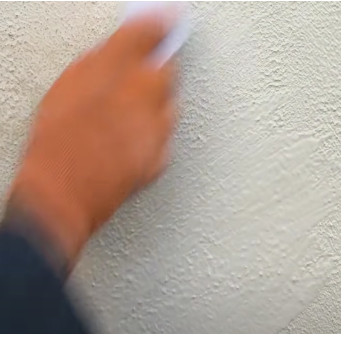
Don't let the water get into air vents for the boiler flue outlet.
Alternatively, you can use a low-pressure jet washer. High-pressure on a pressure washer can cause paint to peel off the wall and soak the wall deeply. A low-pressure setting can effectively clean the surface without damaging it.
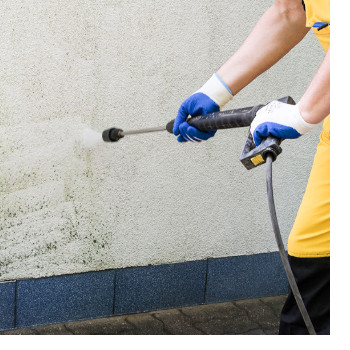
REPAIRING CRACKS
If the suffice has small cracks or small areas of damaged render you can repair this using a suitable external filler. You can also buy powder fillers that you mix on site. Ensure the damaged area is free from loose material.
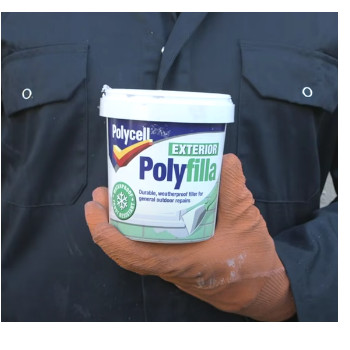
Slightly damp in the area to be filled ideally using a spray bottle.
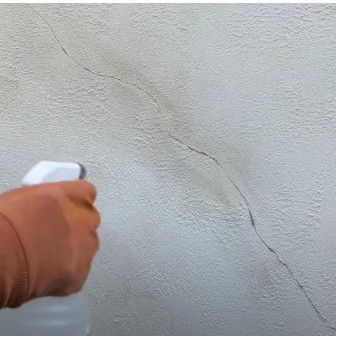
Use the corner of the filler knife to form an inverted V shape along the surface of any crack. This will help the filler to stay in place.
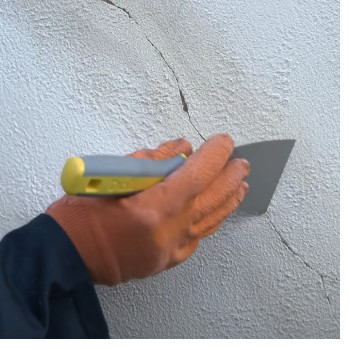
Stir the filler in the tub until it’s creamy in consistency. Apply the filler to the damaged area with a filling knife and smooth off with a wet filling knife.
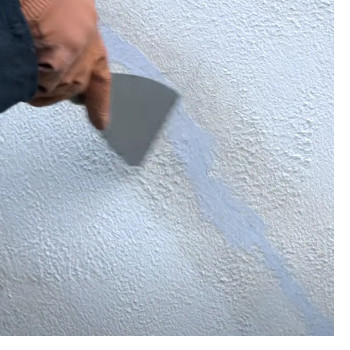
If the crack or damaged area is less than 10mm you should be able to fill it in one go. If is deeper than 10mm you’ll need to build up in layers leaving each layer to dry between applications
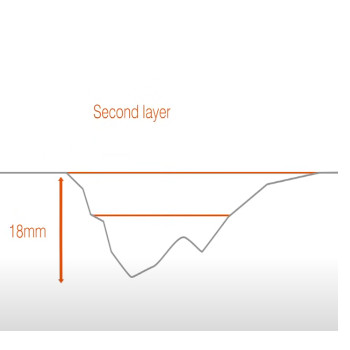
Once it is all dry you can sand down as required.
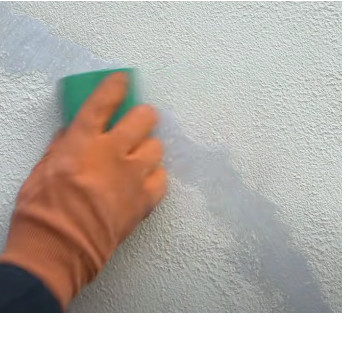
STAINS
To get rid of stains, the best idea is to use oil base paint. Apply the affected area using a large paintbrush. Don’t dilute the paint.
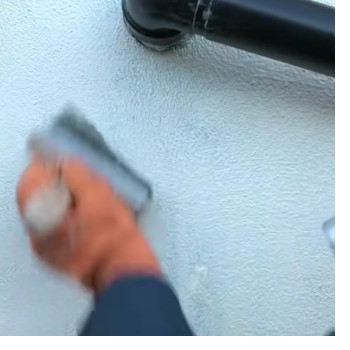
PAINT THE WALL WITH RIGHT TOOLS
 To paint an exterior wall, it is best to use a 12 inch roller, powerlock extension pole and 3 inch good quality brush such as Purdy. Bigger rollers not only cover more surface area than a paint brush, but they give you a nice even finish, too. The best time to paint exterior walls is definitely not when there are clouds looming overhead. Painting during or right before a rainstorm can result in a wasted effort and extra costs, as the paint may simply wash away.
To paint an exterior wall, it is best to use a 12 inch roller, powerlock extension pole and 3 inch good quality brush such as Purdy. Bigger rollers not only cover more surface area than a paint brush, but they give you a nice even finish, too. The best time to paint exterior walls is definitely not when there are clouds looming overhead. Painting during or right before a rainstorm can result in a wasted effort and extra costs, as the paint may simply wash away.
Additionally, it's important to avoid painting during extremely hot or cold weather, as this can cause the paint to dry too quickly or not adhere properly to the surface. Ideally, you should paint on a dry day with mild temperatures, low humidity, and little to no wind. Eight out of ten painters say that using professional tools saves both time and paint.
That's why it's important to choose professional PURDY tools.
PRINCIPLES
BE CLEVER
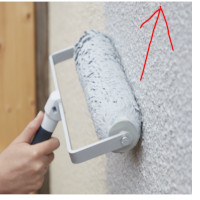 Most people paint exterior walls by starting at the top and working their way down. However, this is an incorrect method. When painting from top to bottom, the paint often drips down the roller and gets rubbed into the upper part of the wall. On the other hand, when painting from the bottom up, the paint is squeezed out of the roller and gradually spread along the entire length of the wall as the work progresses.
Most people paint exterior walls by starting at the top and working their way down. However, this is an incorrect method. When painting from top to bottom, the paint often drips down the roller and gets rubbed into the upper part of the wall. On the other hand, when painting from the bottom up, the paint is squeezed out of the roller and gradually spread along the entire length of the wall as the work progresses.
Therefore, the best and most economical method for painting an exterior wall is to start from the bottom and work your way up. To put this into perspective, imagine sweeping a wall to remove dirt. Starting from the bottom, the dirt would be rubbed into the wall as the brush moves upward.
Experienced decorators in the UK often paint walls using this method, as it leads to savings on paint, minimises the risk of paint splattering on the floor, and ensures that the paint is well spread and blended on the wall. Try to minimise painting with a roller without an extension pole. Your hand will quickly tire, and it won't apply enough pressure to the wall. It's better to use an extension pole to make the job easier and more efficient.
CUT WISELY
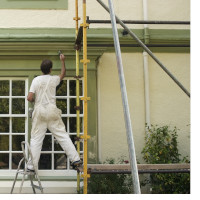 Cutting in with a brush is another essential element of painting the exterior walls, especially for hard-to-reach areas. Dip the brush about 10mm into the paint kettle and then wipe off the excess on the side of the can. Remember to do this in just one spot to keep your hands and brush clean.
Cutting in with a brush is another essential element of painting the exterior walls, especially for hard-to-reach areas. Dip the brush about 10mm into the paint kettle and then wipe off the excess on the side of the can. Remember to do this in just one spot to keep your hands and brush clean.
Any excess paint on the handle of the brush should be wiped off quickly with a cloth to avoid having more paint on your hand than on the brush hairs after an hour of work.
After all, we want to know which part is for painting!
Professional painters rarely use masking tape around lamps, switches, windows, or doors. If you work cleanly, using masking tape is an unnecessary process that takes a lot of time and often causes damage if left on for too long. Just maintain cleanliness and discipline while painting so you don't have to tape everything up.
Remember, if you accidentally paint your pet, it's not a new breed of animal - it's just a painted pet!
BE FAST
The best and fastest tactic for painting exterior walls is to first paint the large surfaces with a roller, and then use a brush to "cut in" the edges. This is because when using a roller first, we can reach the most difficult and hard-to-reach areas, such as window sills or roof soffits, with maximum coverage. This leaves only a small surface area to be finished by hand with a brush, resulting in a quicker overall painting process.
By being able to stand off from the wall you’re painting, you have a better view of how the paint is being laid down to prevent patchiness. Don't worry too much about getting perfect coverage on the first coat – you'll be applying a second coat later. And make sure to take breaks every once in a while to rest your arms.
BE CLEAN
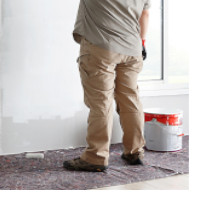 A good practice is to use only one dust sheet and move it along with the progress of the paint roller or brush. This way, we ensure that we don't allow any paint splatters to go beyond the area covered by the dust sheet. This saves us time on cleanup, paint, and makes our work look clean and pleasant. Remember, we're painting an exterior wall, not the floor!
A good practice is to use only one dust sheet and move it along with the progress of the paint roller or brush. This way, we ensure that we don't allow any paint splatters to go beyond the area covered by the dust sheet. This saves us time on cleanup, paint, and makes our work look clean and pleasant. Remember, we're painting an exterior wall, not the floor!
HOW TO PAINT OUTSIDE OF THE HOUSE WITHOUT SCAFFOLDING?
 First thing first you should remember that work at height means work in any place where, if there were no precautions in place, a person could fall a distance liable to cause personal injury. For example you are working at height if you:
First thing first you should remember that work at height means work in any place where, if there were no precautions in place, a person could fall a distance liable to cause personal injury. For example you are working at height if you:
- are working on a ladder or a flat roof;
- could fall through a fragile surface;
- could fall into an opening in a floor or a hole in the ground.
HSE regulations don't apply to a private individual working on his own house but it is worth considering the number of deaths and injuries that occur in this way. For more information regarding working at height regulations from HSE, click here
If you have decided to paint a wall without using scaffolding, you should avoid using a ladder as much as possible. The rule of thumb is that 90% of the work should be done on foot and 10% on the ladder. When using a ladder, it should be positioned 1 metre away from the wall for every 4 metres of height.
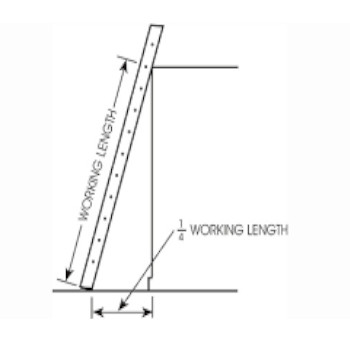
For higher elevations, it's a good idea to ask a neighbour for help holding the ladder steady at the bottom. Who knows, it might be the perfect chance to get to know them!
The ladder should be stable and have a hook at the top for hanging the paint. If you've already painted the wall with a roller, it's a good practice to wrap the ladder ends with a soft cloth or rag to avoid soiling the wall. Keep in mind that the painting range from a ladder is very short, so you'll need to move the ladder frequently.
It's best to secure the bottom of the ladder with something heavy or prop it up permanently. The ladder steps should not be damp or wet.
Picture credit:achrnews.com
youtube.com, B&Q, ‘How to prepare an external wall for painting’, mpeg, 5 December 2013, accessed 30 March 2023,
Realted articles:
EXTERNAL WALL INSULATION. THE UGLY TRUTH
*All the information provided in the content published on Insulationgo blog is for informational and educational purposes only. Insulationgo LTD makes every effort to ensure the accuracy and timeliness of the content, but we do not assume any responsibility for any errors or omissions.
The information presented on this blog should not be considered as professional advice or a substitute for consulting relevant experts. Before making any purchase decisions or taking action based on the information presented here, it is strongly recommended to contact the product manufacturer directly to verify the details and ensure its suitability for your specific needs.
By using this blog, you acknowledge and agree that Insulationgo LTD shall not be held liable for any damages, losses, or inconveniences arising from the use or reliance on the information provided herein. This limitation of liability applies to all users of the blog, including but not limited to visitors, readers, and subscribers.










































































































